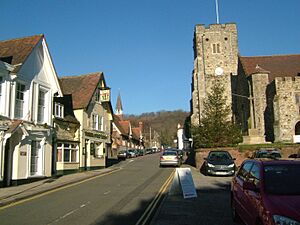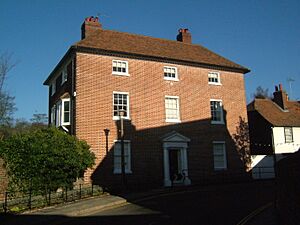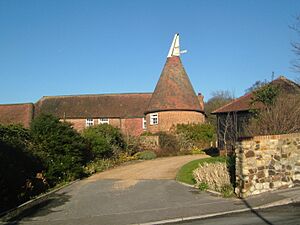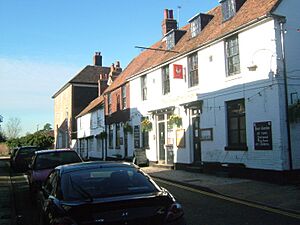Wrotham facts for kids
Quick facts for kids Wrotham |
|
|---|---|
 High Street, Wrotham, showing St George’s Church at right |
|
| Population | 1,815 (2001) 1,921 (2011) |
| OS grid reference | TQ610591 |
| District | |
| Shire county | |
| Region | |
| Country | England |
| Sovereign state | United Kingdom |
| Post town | SEVENOAKS |
| Postcode district | TN15 |
| Dialling code | 01732 |
| Police | Kent |
| Fire | Kent |
| Ambulance | South East Coast |
| EU Parliament | South East England |
| UK Parliament |
|
Wrotham (pronounced ROO-təm) is a village in Kent, England. It is located on the Pilgrims' Way, which is a historic path. The village sits at the bottom of the North Downs, a range of hills. Wrotham is about 1 mile north of Borough Green and 5 miles east of Sevenoaks. It is also found between the M20 and M26 motorways.
Contents
History of Wrotham
The name Wrotham first appeared in the year 788. It means 'homestead of a man called Wrōta'. A "homestead" is like a home and the land around it.
A smaller village called Wrotham Heath is about 1.5 miles to the south-east. It grew on what used to be a large area of shared land.
People believe that the Romans lived in Wrotham a long time ago. There are many signs of their presence. The Wrotham Pinot is a special type of grape that resists diseases. It was found in Wrotham churchyard. Some think it came from grapevines brought by the Romans.
The church of St George is very old, built in the Early English style. Near the church, there was once a palace. This palace belonged to the Archbishop of Canterbury, a very important church leader. It was used until around the year 1350.
Wrotham Hill, to the north, was an important spot in the 1700s. It was used for a special survey that measured distances. This survey connected the Greenwich Royal Observatory in England with the Paris Observatory in France. General William Roy led this project.
Close by is the Wrotham transmitting station. This station was the first in the UK to broadcast radio on FM in 1955. Today, it sends out the main national FM radio signals for most of London.
Wrotham's Old Divisions
Long ago, Wrotham was part of a larger area called the Hundred of Wrotham. A "Hundred" was an old way to divide land for local government. Wrotham village made up a big part of this Hundred.
How Wrotham is Governed
Wrotham is a civil parish. This means it has its own local council. It is part of the Tonbridge and Malling district. The parish has 8 councillors who are chosen by the people.
Wrotham is also a "ward" within the Tonbridge & Malling District Borough Council. A "ward" is an area that elects one or more representatives. This council has 53 seats. The council is in charge of local services. These include things like parks, collecting trash, and council housing.
The Kent County Council is also important. It handles bigger services like education, social services, and checking product quality. Both councils work together on town planning and road repairs.
Wrotham is part of the parliamentary constituency of Tonbridge and Malling. This area chooses a Member of Parliament (MP) to represent them in the UK Parliament. Since 1974, two MPs have represented this area. They are Sir John Stanley (from 1974 to 2015) and Tom Tugendhat (from 2015 onwards). Both are from the Conservative Party.
Changes Over Time
Wrotham used to be much larger. It included areas like Borough Green, Platt, Plaxtol and Stansted. Over time, these areas became separate parishes.
In 1863, Wrotham parish got a local government board. This board helped manage the area. Later, in 1894, these boards became "urban districts." Even though it was named after Wrotham, the council for this district was based in Borough Green. Borough Green was growing bigger because a railway station opened there in 1874.
The Wrotham Urban District was ended in 1934. Its area was then split into new parishes like Borough Green, Platt, Plaxtol, and Wrotham. In 1974, these areas became part of Tonbridge and Malling.
People of Wrotham
The table below shows some facts about the people living in Wrotham. It compares Wrotham to the Tonbridge & Malling district and to England as a whole.
| Wrotham | Tonbridge & Malling district | England | |
|---|---|---|---|
| Population | 1,815 | 107,561 | 49,138,831 |
| UK born | 95.9% | 95.4% | 91.8% |
| White | 99% | 98% | 91% |
| Asian | 0.0% | 0.5% | 4.6% |
| Black | 0.16% | 0.14% | 2.3% |
| Christian | 75% | 76% | 72% |
| Muslim | 0.2% | 0.3% | 3.1% |
| Hindu | 0.0% | 0.2% | 1.1% |
| Source: 2001 UK census | |||
In 2001, Wrotham had 1,815 people living there. There were 759 households, which are groups of people living together. About 42% were married couples, and 29% were individuals living alone.
Most people in the village (99.2%) were white. The main religion was Christian (74.81%). About 15.46% of people said they had no religion.
Wrotham's Economy
In 2001, about 39.5% of people aged 16–74 in Wrotham worked full-time. Another 12.9% worked part-time. About 14.1% were self-employed, meaning they worked for themselves. Only 1.6% were unemployed, which is a low number compared to the rest of the country.
Many people worked in retail (16%), which means selling things in shops. Other common jobs were in real estate (14%), manufacturing (13%), and construction (10%). Wrotham had more people working in farming, energy, water supply, hotels, restaurants, and construction compared to the national average. It had fewer people working in health care and public services.
The average household income in Wrotham between 2001 and 2002 was about £770 per week, or £40,000 per year.
Local Businesses
Wrotham has several small businesses that serve the community. There are also a few pubs very close to each other. These include the Rose and Crown, the George and Dragon, and the Bull Hotel. Another pub, the Three Postboys, closed in 2009.
Notable People from Wrotham
- Peaches Geldof: An English journalist, TV presenter, and model. She lived in Wrotham and passed away there in 2014.
- Field Marshal Henry Hardinge, 1st Viscount Hardinge: A British Army officer and politician. He was born in the village in 1785.
- Lieutenant Colonel Alfred Wintle: A British Army officer known for being a bit unusual. He died in the village in 1966.
See also
 In Spanish: Wrotham para niños
In Spanish: Wrotham para niños





